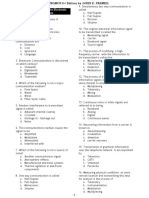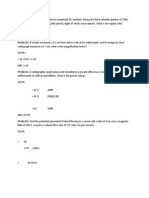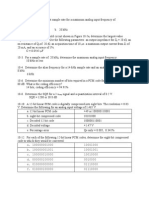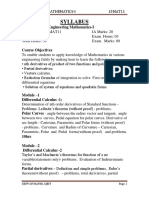Activity 3-Elementary Mathematical Functions in LabVIEW
Uploaded by
Melric LamparasActivity 3-Elementary Mathematical Functions in LabVIEW
Uploaded by
Melric LamparasECE 100 Fundamentals of LabVIEW Programming
MATHEMATICAL FUNCTIONS in LABVIEW
Activity No. 3
I. INTENDED LEARNING OUTCOMES
At the end of this activity, the student shall be able to:
1. Enumerate the Mathematical Functions in LabVIEW and discuss its functions.
2. Use the Mathematical Functions of LabVIEW to analyze set of data according to set
criteria.
3. Apply mathematical functions in LabVIEW to create a useful VI.
II. BACKGROUND INFORMATION
The previous activity has focused in the development of LabVIEW program using basic arithmetic,
comparison and Boolean functions. This activity is a one-level higher continuation of Activity No. 2 which
will be focusing on the use of elementary mathematical functions of LabVIEW. The elementary and special
functions in LabVIEW include trigonometric, exponential, hyperbolic functions but not limited to discrete
mathematics, Bessel functions, linear algebra, curve fitting, interpolation, extrapolation and optimization.
LabVIEW can be used to interpret data that require the use and application of higher mathematical
operations. A number of engineering design and analysis depends on how data will be treated. Say for
instance, a set of data coming from a controlled experiment is tabulated and then plotted against the x and
y axes. The programmer then noticed that the data points obtained are scattered everywhere in the plane.
Mathematically, these data are remained untreated such that they cannot be evaluated directly by
modelling the behaviour of experiment as a mathematical equation. To easily interpret these data, curve
fitting may be employed. This means that the scattered data points may be represented closely by a
geometric function including linear, polynomial and cubic function.
Another application that a LabVIEW platform can administer is optimization. This technique is used
to select the best possible elements in a group of data depending on a given criteria. For example, a metal
can factory wants to design a can for preserved foods. Using the optimization techniques in LabVIEW the
company can decide on how much dimensions of the can will give them the minimum cost of production
with maximum capacity as much as possible.
LabVIEW also offers tools for statistics. It includes measures of central tendency like mean,
median and mode. Might as well, LabVIEW has the ability to interpret complex function, mathematical
functions containing real and imaginary elements.
To access the above functions, right-click anywhere in the block diagram
windowMathematics. All functions that are not mentioned previously are located in that menu. To use
the said functions, everyone should have a strong foundation in Engineering Mathematics including
Algebra, Geometry, Calculus, Differential Equations, Advanced Engineering Mathematics, Probability and
Statistics, Linear Algebra and Discrete Mathematics.
Page 21
ECE 100 Fundamentals of LabVIEW Programming
III. LEARNING ACTIVITIES
ACTIVITY 3.1: TRIGONOMETRIC FUNCTIONS
1. Open LabVIEW 2012 and let the Front Panel and Block Diagram windows appear. On the Block
diagram
window,
right-click
anywhere
in
the
empty
space
and
choose
MathematicsElementaryTrigonometric and drag and drop the six basic trigonometric functions sin,
cos, tan, csc, sec and cot.
2. On the Front Panel window, drag and drop a Knob control and connect the Knob control output node
to the input nodes of the trigonometric functions. Change the scale of the Knob control from 0 (minimum)
to 3.5 (maximum). Put Numeric Indicators for the output of the corresponding trigonometric function. Save
your VI as Act3_1_1.VI
3. Click on the Run Continuously button and adjust the control knob as follows:
a. 1.25
c. 1.57
b. 0.56
d. 3.13
Question: Explain how the VI works?
Page 22
ECE 100 Fundamentals of LabVIEW Programming
4. Consider the table below. Record the values of the six trigonometric functions for the given values below:
Input values
0.00
0.50
1.00
1.50
2.00
2.50
3.00
SIN
COS
TAN
CSC
SEC
COT
5. Verify using your scientific calculator in DEGREE mode the values recorded on the table above.
Question: Compare the results of the values tabulated above with the values you have computed
using your scientific calculator. Is there any difference in the value? If there is a difference, why do
you think so?
6. Modify the VI such that the value on your program and scientific calculator matches without omitting
the values of control knob. Save the modified VI as Act3_1_2.VI. SCREEN-CAPTURE the Front Panel
and Block Diagram for this procedure and include it in your activity report.
ACTIVITY 3.2: EXPONENTIAL FUNCTIONS
1. Clear the Front Panel and the Block Diagram from the
previous activity done. Create a Front Panel VI as shown
below: Save VI as Act3_2_1.VI
2. On the Block Diagram
Window, drag and drop
Exponential functions. RightClick anywhere in an empty
Space, go to Mathematics
ElementaryExponential
And drag and drop the ff:
a. Exponential
b. Exponential Arg (-1)
c. Power of 10
d. Power of 2
e. Logarithm Base-10
f. Natural Logarithm
Page 23
ECE 100 Fundamentals of LabVIEW Programming
3. Connect the Exponential function to Numeric Indicator labelled as Output 1. Connect Exponential
Arg (-1) to Numeric Indicator labelled as Output 2. Connect the other functions in their respective
indicators following the sequence from c to f in the previous page.
4. Consider the table below. Record the values for the given values below:
Input values Exponential
Exp Arg (-1)
Power of 10
Power of 2
Log Base
10
Natural
Logarithm
0.00
0.50
1.00
1.50
2.00
2.50
3.00
3.50
4.00
4.50
5.00
5.50
6.00
6.50
7.00
7.50
8.00
8.50
9.00
9.50
10.00
Question: Explain each functions used in the calculation of the tables given above.
Question: What are the other functions under Exponential and explain each function?
Page 24
ECE 100 Fundamentals of LabVIEW Programming
ACTIVITY 3.3: EXPONENTIAL FUNCTIONS
1. Clear the Front Panel and the Block Diagram from the previous activity done. Create a Front Panel VI
as shown below:
2. On the Block Diagram, drag and drop the six hyperbolic functions and connect to its numeric indicator
labeled Output 1 to Output 6 respectively. The hyperbolic functions in sequence should be sinh, cosh,
tanh, sech, csch, coth respectively. Save your VI as Act3_3_1.VI
3. Consider the table below. Record the values for the given values below:
Input values
sinh
cosh
tanh
csch
0.00
0.50
1.00
1.50
2.00
2.50
3.00
3.50
4.00
4.50
5.00
5.50
6.00
6.50
7.00
sech
tanh
Page 25
ECE 100 Fundamentals of LabVIEW Programming
7.50
8.00
8.50
9.00
9.50
10.00
Question: Explain each functions used in the calculation of the tables given above.
Question: What are the other functions under Hyperbolic Functions and explain each function?
IV. MACHINE PROBLEM
1. Given the following equations for a catenary
Where s is half of the rope length, a is the parameter related to the mass of the rope and the acceleration
due to gravity, and L is half the distance of the posts supporting the rope. The sag of the rope is given as:
Create a VI that will allow to compute the value of d for each of the given s and L from 0 to 1000. Use
a dedicated control knob and customize your VI. Save your VI as MacPro3_1.VI
2. The Taylor Series expansion for the hyperbolic sine function is given as:
While for the hyperbolic cosine is:
Where n is the number of terms to be added to the series. Create a VI that would compute the sum of the
first ten terms of the Taylor Series expansion for the hyperbolic sine and hyperbolic cosine of an input x,
calling this VI as HypTaylor.VI
Page 26
ECE 100 Fundamentals of LabVIEW Programming
V. ASSESSMENT TASKS
1. What are the other Mathematics functions in LabVIEW apart from Trigonometric, Exponential and
Inverse Hyperbolic functions? Enumerate their functions and define when they can be used?
2. What is the importance of having Mathematical functions in creating a program using LabVIEW?
3. When using a trigonometric function such that you want to compute for the six trigonometric functions of
a given angle, how does LabVIEW interpret your input value?
4. Can we use the Mathematical functions of LabVIEW in the operation of an external device from the
platform itself? How and why?
VI. CONCLUSION
VII. RUBRICS FOR LABORATORY PERFORMANCE
Page 27
You might also like
- Classifications of Signals: ECE 593: Signal, Spectra and Signal Processing Course OutlineNo ratings yetClassifications of Signals: ECE 593: Signal, Spectra and Signal Processing Course Outline6 pages
- Chapter 1: Introduction To Electronic CommunicationsNo ratings yetChapter 1: Introduction To Electronic Communications33 pages
- Laboratory 1 Discrete and Continuous-Time SignalsNo ratings yetLaboratory 1 Discrete and Continuous-Time Signals8 pages
- Digital and Data Communication NetworksNo ratings yetDigital and Data Communication Networks49 pages
- 9-Frequency Spectrum, Power relation-17-Dec-2019Material - I - 17-Dec-2019 - Extract - Pages - From - 2 PDFNo ratings yet9-Frequency Spectrum, Power relation-17-Dec-2019Material - I - 17-Dec-2019 - Extract - Pages - From - 2 PDF10 pages
- MCQ in Differential Calculus (Limits and Derivatives) Part 1 - Math Board ExamNo ratings yetMCQ in Differential Calculus (Limits and Derivatives) Part 1 - Math Board Exam13 pages
- Excel Review Center ECE Refresher/Coaching Estth1100% (1)Excel Review Center ECE Refresher/Coaching Estth14 pages
- LESSON 2 Process Variables and Signals ISA SYMBOLSNo ratings yetLESSON 2 Process Variables and Signals ISA SYMBOLS39 pages
- MULTIPLE CHOICE. Choose The One Alternative That Best Completes The Statement or Answers The QuestionNo ratings yetMULTIPLE CHOICE. Choose The One Alternative That Best Completes The Statement or Answers The Question4 pages
- BPSU Philippines - Microwave Link CommunNo ratings yetBPSU Philippines - Microwave Link Commun69 pages
- (ELECS2) Exp3 - Darlington and Cascode Amplifier Circuits100% (2)(ELECS2) Exp3 - Darlington and Cascode Amplifier Circuits17 pages
- Electronic Communication System, Chapter 7 AnsNo ratings yetElectronic Communication System, Chapter 7 Ans16 pages
- Lesson 1 Introduction To Principles of CommunicationNo ratings yetLesson 1 Introduction To Principles of Communication74 pages
- Lab No.3 Discrete Time Systems in Time Domain Impulse Response of Lti SystemNo ratings yetLab No.3 Discrete Time Systems in Time Domain Impulse Response of Lti System5 pages
- Digital Transmission Items Definitions TermsNo ratings yetDigital Transmission Items Definitions Terms5 pages
- ECE 314B Principles of Communication Systems WK10to13 ModuleNo ratings yetECE 314B Principles of Communication Systems WK10to13 Module30 pages
- Communication Electronics Chapter Summary FrenzelNo ratings yetCommunication Electronics Chapter Summary Frenzel15 pages
- Activity 3 Elementary Mathematical Functions in LabVIEW 1No ratings yetActivity 3 Elementary Mathematical Functions in LabVIEW 18 pages
- Elementary Mathematical Functions in LabVIEWNo ratings yetElementary Mathematical Functions in LabVIEW7 pages
- Activity 3 Elementary Mathematical Functions in LabVIEWNo ratings yetActivity 3 Elementary Mathematical Functions in LabVIEW7 pages
- Ece 100 Fundamentals of Labview ProgrammingNo ratings yetEce 100 Fundamentals of Labview Programming17 pages
- FX 9750 G+ Calculator Tricks With ActivitiesNo ratings yetFX 9750 G+ Calculator Tricks With Activities58 pages
- Activity 2-Arithmetic Comparision and Boolean Operations in LabVIEWNo ratings yetActivity 2-Arithmetic Comparision and Boolean Operations in LabVIEW9 pages
- Eee-I-Engineering Mathematics I (15mat11) - Notes PDFNo ratings yetEee-I-Engineering Mathematics I (15mat11) - Notes PDF165 pages
- Eee I Engineering Mathematics I (15mat11) NotesNo ratings yetEee I Engineering Mathematics I (15mat11) Notes165 pages
- Generated By: Bravomt Date/Time: 18-01-03 10:25:11: Page 1/2No ratings yetGenerated By: Bravomt Date/Time: 18-01-03 10:25:11: Page 1/22 pages
- Amplitude Modulation: Technological Institute of The PhilippinesNo ratings yetAmplitude Modulation: Technological Institute of The Philippines1 page
- PDF of A Scot in The Dark Sarah Maclean Full Chapter Ebook100% (12)PDF of A Scot in The Dark Sarah Maclean Full Chapter Ebook69 pages
- DSA - List of Experiments From Virtual Lab Portal - Additional PracticeNo ratings yetDSA - List of Experiments From Virtual Lab Portal - Additional Practice6 pages
- Lecture - 1 - Molecular Structure of Skeletal Muscle and Function of Nerve-Muscle JunctionNo ratings yetLecture - 1 - Molecular Structure of Skeletal Muscle and Function of Nerve-Muscle Junction16 pages
- 34 WaterScienceandTechnology2013 duPisaniMengeNo ratings yet34 WaterScienceandTechnology2013 duPisaniMenge15 pages
- Module 1 - Introduction To Numerical Methods PDFNo ratings yetModule 1 - Introduction To Numerical Methods PDF20 pages
- Test Frequency and Acceptance Criteria: Subgrade/Shoulder/Median75% (4)Test Frequency and Acceptance Criteria: Subgrade/Shoulder/Median6 pages
- Classifications of Signals: ECE 593: Signal, Spectra and Signal Processing Course OutlineClassifications of Signals: ECE 593: Signal, Spectra and Signal Processing Course Outline
- Chapter 1: Introduction To Electronic CommunicationsChapter 1: Introduction To Electronic Communications
- 9-Frequency Spectrum, Power relation-17-Dec-2019Material - I - 17-Dec-2019 - Extract - Pages - From - 2 PDF9-Frequency Spectrum, Power relation-17-Dec-2019Material - I - 17-Dec-2019 - Extract - Pages - From - 2 PDF
- MCQ in Differential Calculus (Limits and Derivatives) Part 1 - Math Board ExamMCQ in Differential Calculus (Limits and Derivatives) Part 1 - Math Board Exam
- LESSON 2 Process Variables and Signals ISA SYMBOLSLESSON 2 Process Variables and Signals ISA SYMBOLS
- MULTIPLE CHOICE. Choose The One Alternative That Best Completes The Statement or Answers The QuestionMULTIPLE CHOICE. Choose The One Alternative That Best Completes The Statement or Answers The Question
- (ELECS2) Exp3 - Darlington and Cascode Amplifier Circuits(ELECS2) Exp3 - Darlington and Cascode Amplifier Circuits
- Lesson 1 Introduction To Principles of CommunicationLesson 1 Introduction To Principles of Communication
- Lab No.3 Discrete Time Systems in Time Domain Impulse Response of Lti SystemLab No.3 Discrete Time Systems in Time Domain Impulse Response of Lti System
- ECE 314B Principles of Communication Systems WK10to13 ModuleECE 314B Principles of Communication Systems WK10to13 Module
- Activity 3 Elementary Mathematical Functions in LabVIEW 1Activity 3 Elementary Mathematical Functions in LabVIEW 1
- Activity 3 Elementary Mathematical Functions in LabVIEWActivity 3 Elementary Mathematical Functions in LabVIEW
- Activity 2-Arithmetic Comparision and Boolean Operations in LabVIEWActivity 2-Arithmetic Comparision and Boolean Operations in LabVIEW
- Eee-I-Engineering Mathematics I (15mat11) - Notes PDFEee-I-Engineering Mathematics I (15mat11) - Notes PDF
- Generated By: Bravomt Date/Time: 18-01-03 10:25:11: Page 1/2Generated By: Bravomt Date/Time: 18-01-03 10:25:11: Page 1/2
- Amplitude Modulation: Technological Institute of The PhilippinesAmplitude Modulation: Technological Institute of The Philippines
- PDF of A Scot in The Dark Sarah Maclean Full Chapter EbookPDF of A Scot in The Dark Sarah Maclean Full Chapter Ebook
- DSA - List of Experiments From Virtual Lab Portal - Additional PracticeDSA - List of Experiments From Virtual Lab Portal - Additional Practice
- Lecture - 1 - Molecular Structure of Skeletal Muscle and Function of Nerve-Muscle JunctionLecture - 1 - Molecular Structure of Skeletal Muscle and Function of Nerve-Muscle Junction
- Test Frequency and Acceptance Criteria: Subgrade/Shoulder/MedianTest Frequency and Acceptance Criteria: Subgrade/Shoulder/Median




































































































